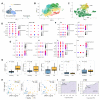Single-cell RNA sequencing reveals rebalancing of immunological response in patients with periodontitis after non-surgical periodontal therapy
- PMID: 36329504
- PMCID: PMC9635198
- DOI: 10.1186/s12967-022-03702-2
Single-cell RNA sequencing reveals rebalancing of immunological response in patients with periodontitis after non-surgical periodontal therapy
Abstract
Background: Periodontitis is a major inflammatory disease of the oral mucosa that is not limited to the oral cavity but also has systemic consequences. Although the importance of chronic periodontitis has been emphasized, the systemic immune response induced by periodontitis and its therapeutic effects remain elusive. Here, we report the transcriptomes of peripheral blood mononuclear cells (PBMCs) from patients with periodontitis.
Methods: Using single-cell RNA sequencing, we profiled PBMCs from healthy controls and paired pre- and post-treatment patients with periodontitis. We extracted differentially expressed genes and biological pathways for each cell type and calculated activity scores reflecting cellular characteristics. Intercellular crosstalk was classified into therapy-responsive and -nonresponsive pathways.
Results: We analyzed pan-cellular differentially expressed genes caused by periodontitis and found that most cell types showed a significant increase in CRIP1, which was further supported by the increased levels of plasma CRIP1 observed in patients with periodontitis. In addition, activated cell type-specific ligand-receptor interactions, including the BTLA, IFN-γ, and RESISTIN pathways, were prominent in patients with periodontitis. Both the BTLA and IFN-γ pathways returned to similar levels in healthy controls after periodontal therapy, whereas the RESISTIN pathway was still activated even after therapy.
Conclusion: These data collectively provide insights into the transcriptome changes and molecular interactions that are responsive to periodontal treatment. We identified periodontitis-specific systemic inflammatory indicators and suggest unresolved signals of non-surgical therapy as future therapeutic targets.
Keywords: CRIP1; Chronic periodontitis; Immune response; RESISTIN; Single-cell RNA sequencing; Therapeutic target.
© 2022. The Author(s).
Conflict of interest statement
Patents pending by the authors and their institutions.
Figures






Similar articles
-
Gingival crevicular fluid resistin levels in chronic periodontitis with type 2 diabetes before and after non-surgical periodontal therapy: A clinico-biochemical study.Indian J Dent Res. 2019 Jan-Feb;30(1):47-51. doi: 10.4103/ijdr.IJDR_215_17. Indian J Dent Res. 2019. PMID: 30900656
-
Resistin and Plasma-reactive Oxygen Metabolite Levels in Obese and Non-obese Individuals with Chronic Periodontitis in Response to Non-surgical Periodontal Therapy.J Contemp Dent Pract. 2018 Dec 1;19(12):1525-1530. J Contemp Dent Pract. 2018. PMID: 30713184
-
Single-cell RNA landscape of the osteoimmunology microenvironment in periodontitis.Theranostics. 2022 Jan 1;12(3):1074-1096. doi: 10.7150/thno.65694. eCollection 2022. Theranostics. 2022. PMID: 35154475 Free PMC article.
-
Evaluation of Reactive Oxygen Metabolites, Resistin, and Red Complex Bacteria in Obese Subjects with or without Periodontitis.J Contemp Dent Pract. 2022 Jul 1;23(7):703-708. J Contemp Dent Pract. 2022. PMID: 36440516
-
Resistin: a potential biomarker for periodontitis influenced diabetes mellitus and diabetes induced periodontitis.Dis Markers. 2014;2014:930206. doi: 10.1155/2014/930206. Epub 2014 Feb 12. Dis Markers. 2014. PMID: 24692844 Free PMC article. Review.
Cited by
-
Identification of potential resistance mechanisms and therapeutic targets for the relapse of BCMA CAR-T therapy in relapsed/refractory multiple myeloma through single-cell sequencing.Exp Hematol Oncol. 2023 May 8;12(1):44. doi: 10.1186/s40164-023-00402-5. Exp Hematol Oncol. 2023. PMID: 37158921 Free PMC article.
-
Uncovering NK cell sabotage in gut diseases via single cell transcriptomics.PLoS One. 2025 Jan 3;20(1):e0315981. doi: 10.1371/journal.pone.0315981. eCollection 2025. PLoS One. 2025. PMID: 39752457 Free PMC article.
-
The protective role of CD73 in periodontitis: preventing hyper-inflammatory fibroblasts and driving osteoclast energy metabolism.Front Oral Health. 2023 Dec 13;4:1308657. doi: 10.3389/froh.2023.1308657. eCollection 2023. Front Oral Health. 2023. PMID: 38152410 Free PMC article.
-
Comparison of genetic and epigenetic profiles of periodontitis according to the presence of type 2 diabetes.MedComm (2020). 2024 Jun 19;5(7):e620. doi: 10.1002/mco2.620. eCollection 2024 Jul. MedComm (2020). 2024. PMID: 38903536 Free PMC article.
-
Distinct Immunological Features Compared to Lichen Planus and Oral Lichen Planus.J Inflamm Res. 2025 Mar 18;18:4037-4056. doi: 10.2147/JIR.S506313. eCollection 2025. J Inflamm Res. 2025. PMID: 40125076 Free PMC article.
References
-
- Genco RJ, Sanz M. Clinical and public health implications of periodontal and systemic diseases: An overview. Periodontol 2000 2020, 83:7–13. - PubMed
-
- Caton JG, Armitage G, Berglundh T, Chapple ILC, Jepsen S, Kornman KS, Mealey BL, Papapanou PN, Sanz M, Tonetti MS. A new classification scheme for periodontal and peri-implant diseases and conditions - Introduction and key changes from the 1999 classification. J Clin Periodontol. 2018;45(Suppl 20):1–8. - PubMed
-
- Preshaw PM. Host modulation therapy with anti-inflammatory agents. Periodontol 2000 2018, 76:131–149. - PubMed
Publication types
MeSH terms
Substances
LinkOut - more resources
Full Text Sources
Other Literature Sources
Molecular Biology Databases
Research Materials
Miscellaneous

